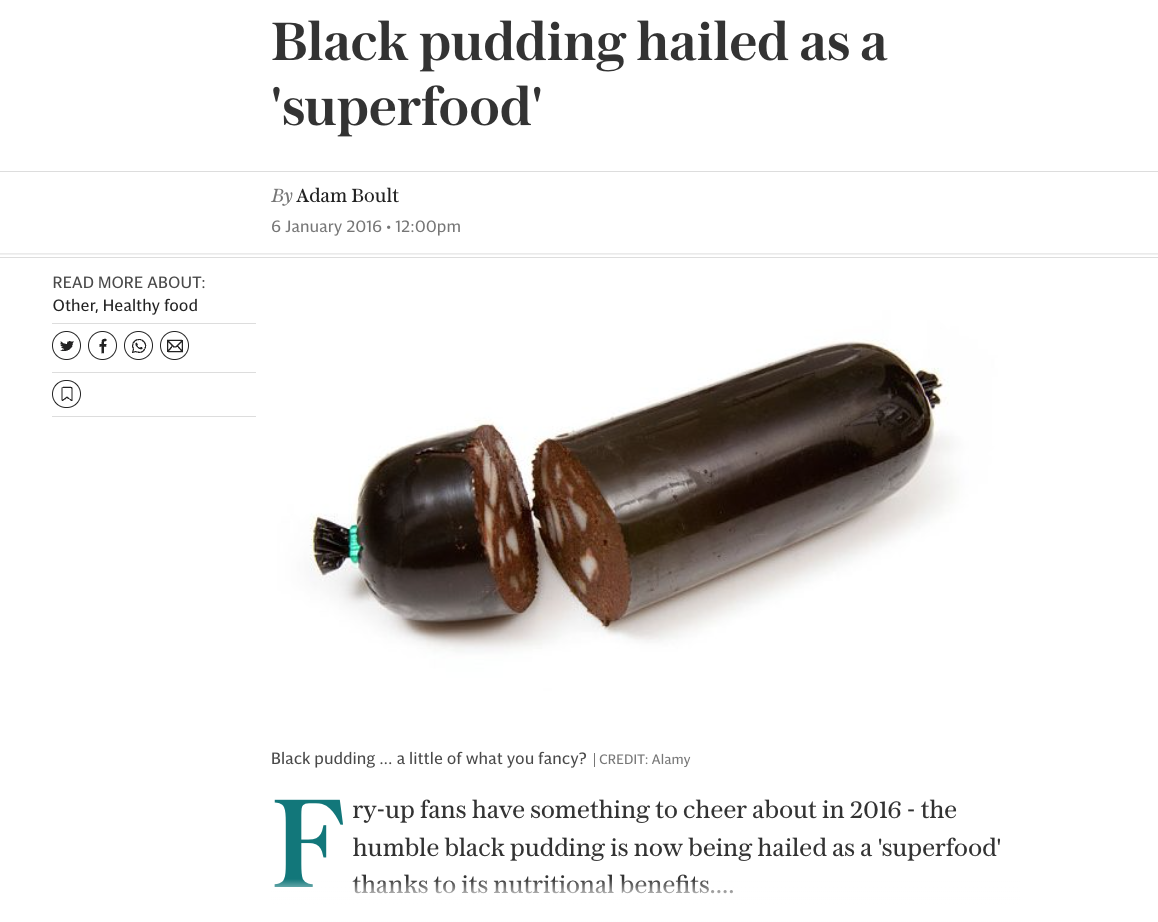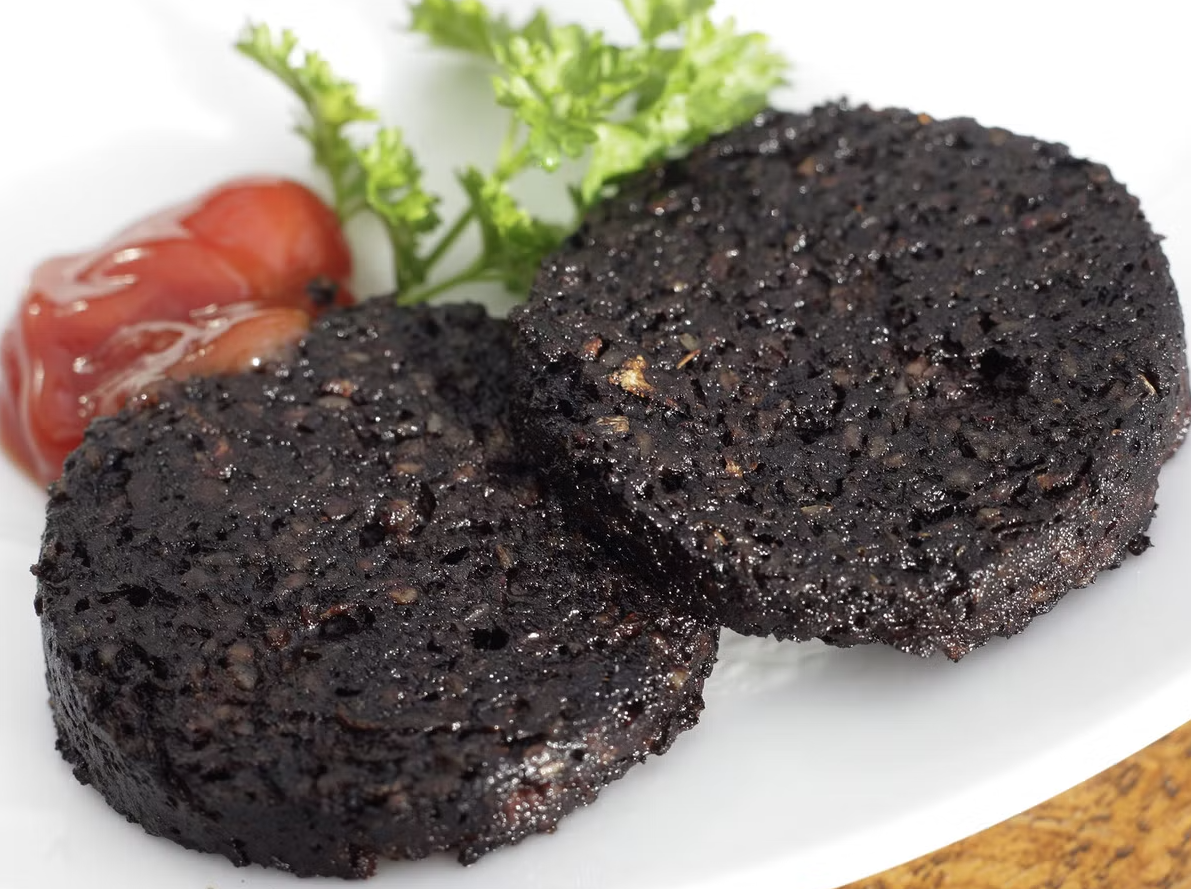Hailed as a SUPERFOOD by several leading UK newspapers…
Black Pudding is ‘surprisingly good for you’ according to The Daily Telegraph.

And The Independent – ‘Fried breakfast lovers are rejoicing as black pudding has reportedly joined the ranks of kale, blueberries and pomegranate as a superfood.’

Really? That’s ridiculous, surely everyone knows it’s full of fat, but it’s featured in very ‘credible’ publications so it must be true…
And this is why the public are confused.
The first thing to consider is what defines a superfood? Most people have no idea – but LOVE the buzzword! And people LOVE to hear good things about bad habits…
So is this a superfood? According to our beloved wikipedia:
“Superfood is a marketing term used to describe foods with supposed health benefits.”
And that’s a pretty good definition. A marketing term. At that point right there – stop. When a term is used in marketing, it is to help sell a product or service, not to define its features.
Black pudding does indeed contain lots of zinc, potassium, calcium, magnesium, iron and protein.
There are health benefits to consuming foods which provide minerals and protein, definitely, but there’s more to it.
Food must be looked at as a complete package, not simply taking some of the constituents and drawing an overall conclusion from those – it doesn’t make sense.
Some of the media releases also brag about how black pudding contains almost ‘no carbs’, is that a good thing? Again, confusion.
So let’s look at this logically.
The first thing to do is understand the complete picture, and to do that we need to consider the nutritional profile of this food.
Let’s grab some raw data from nutritiondata.com.
For every 100 grams of black pudding, you get 379 calories, of which 311 calories come from fat. This does not take a genius to conclude that just over 82% of the calories in this food come from fat. That makes black pudding an extremely high fat food.
Note that the nutritional label shows Total Fat as 35g, so someone may think that the food is 35% fat, and right next to it is shown 53% fat, as a percentage of the daily value.
Already there’s 3 systems – remember that confusion? It’s still there, and what are people focusing on, the clarity – all those great minerals that black pudding offers.
Here’s the real deal….
If you eat this food, you will get those minerals, but you’ll also get a massive amount of fat, including a lot of saturated fat.
You’ll get zero fibre and almost no carbohydrates. Carbohydrates are the only macronutrient your brain can run on. Of course, a lot of this on it’s own doesn’t mean a huge amount to most people and that’s ok – it’s just that more education is needed.
Bear in mind that this nutritional information is per 100 grams of black pudding and that’s about 4 thin slices – not a lot at all. And the amount of salt you’re getting, 1.7 grams – that’s over 100% of what you actually need. Yes, 6 grams is the recommended maximum, but all you already need is 1 gram.
And what are you likely to eat this food with… probably other foods which are extremely high in salt – and that’s one meal. Large amount of salt result in high blood pressure, and high blood pressure kills people.
So, looking at the food overall, Black pudding isn’t a superfood, it’s a stupidfood. It’s best avoided, because 82% of calories come from fat, that super high salt content and cholesterol coupled with no fibre.
This means that it’s likely to leave you hungry (and thirsty) in the short term, and in the long term it’ll contribute to your risk of coronary artery disease, type 2 diabetes, obesity and if you’re female, breast cancer, and if you’re a bloke, erectile dysfunction.
You’ll notice on the case studies page of this website that every person’s health was improved and none of them ate any black pudding whatsoever.
And funnily enough, we weren’t paid to write this article, nor are there any adverts on this website…

